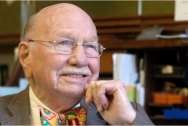 Was born in Scotland, near Gleneagles. He qualified at Edinburgh University in 1939 and joined the army on October 1939. In 1942 he was drafted to India but finished in administration medical charge of half of Ceylon and was demobilised with the rank of Major. After various appointments in Scotland, he was appointed in 1953, as Consultant Chest Physician at Derby. At first, he was dealing mainly with tuberculosis but his interest soon changed to asthma and allergy.
Was born in Scotland, near Gleneagles. He qualified at Edinburgh University in 1939 and joined the army on October 1939. In 1942 he was drafted to India but finished in administration medical charge of half of Ceylon and was demobilised with the rank of Major. After various appointments in Scotland, he was appointed in 1953, as Consultant Chest Physician at Derby. At first, he was dealing mainly with tuberculosis but his interest soon changed to asthma and allergy.
A paper in the Lancet in 1958 showed that patients with asthma who responded to oral steroids depended on the presence of eosinophils for case selection. Based on this, some years later he had dramatic success with this trial being the first to show that inhaled steroids were therapeutic in asthma for which he gained international recognition. He wrote to the Lancet in 2010 about his first paper of fifty two years ago, stating that the paper would now never be published because’ there is only one simple table of results, no statistics, no blinding of the investigator, no objective results from spirometry and only one author.’
He arranged a series of highly successful Charles Blackley Symposia at Derby. They became popular because the clinical rather than the academic side of allergy was discussed.
He was interested in food allergy, but his main interest and greatest continued achievement was founding in 1968 of the Midlands Asthma and Allergy Research Association (MAARA). It funded research particularly developing strong teams in aerobiology.
He studied air spora by various means. He built volumetric and gravity slide methobiologic apparatus. He became interested in nano-particles and their role in pathology. He made a needle for skin prick testing which became commercially available. His microscope had many added attachments.
So much of what we should know about allergy and asthma start in children, or before they are born. Because of this interest, he has endowed a special lecture to be given in his name, every other year at the BSACI annual meeting.